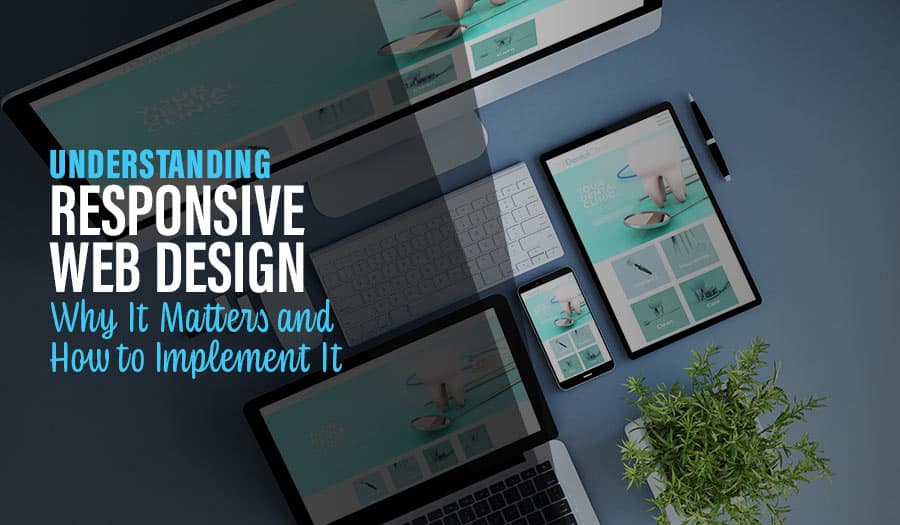In today’s digital landscape, where mobile devices have become integral to our lives, responsive web design has emerged as a crucial element for creating successful websites and digital marketing. Responsive design allows websites to adapt and provide an optimal viewing experience across various devices and screen sizes, ensuring usability, accessibility, and customer satisfaction. Let’s explore Responsive Web Design.
This blog post will delve into the importance of responsive web design and provide practical tips for implementing it effectively.
Responsive Web Design: Why It Matters and How to Implement It
1. The Rise of Mobile: The Need for Responsive Design
With the increasing prevalence of smartphones and tablets, people now access the internet on various devices. This shift in user behaviour necessitates implementing responsive web design to cater to diverse screen sizes and resolutions.
Responsive design enables websites, whether mobile or desktop site to adjust their layout, content, and functionality seamlessly, ensuring a consistent user experience across all devices. Failure to adopt responsive design can result in a poor user experience, increased bounce rates, and missed business opportunities.
In the recent past few years alone, mobile usage has surpassed desktop usage, making businesses need to optimize their websites for mobile devices. According to a report by Statista, mobile devices accounted for approximately 54% of global website traffic in 2021. This trend is expected to grow, making responsive design essential for businesses to effectively get mobile traffic, reach and keep potential customers and engage their target audience.
Impacts of Non Responsive Design for business websites include: Poor user experience, decreased traffic, missed business opportunities and higher bounce rates. Responsive design helps to ensure users have a consistent experience across all devices while improving the overall usability of your website and its performance in organic search results.
A responsive web design will help businesses keep up with the changing digital landscape and remain competitive in their respective markets. It’s essential for businesses to invest in responsive design and leverage the advantages it brings to ensure maximum reach, engagement and conversions. p
Responsive design also offers additional SEO benefits such as improved indexing, better navigational structure, increased page speed and optimized meta tags that can help your website rank higher.
2. Improved User Experience and Usability
Responsive web design plays a pivotal role in enhancing user experience and usability. By prioritizing mobile optimization, websites with responsive design offer intuitive navigation, easy-to-read content, and streamlined interactions.
Users no longer need to zoom in, scroll excessively, or deal with distorted layouts on their mobile smartphones and devices. With responsive design, the website adapts fluidly, providing visitors spend an engaging and seamless experience regardless of the screen size, leading to increased user satisfaction and prolonged engagement.
When users can easily access and navigate a website on their preferred mobile device, they are more likely to stay longer, explore different sections, and convert into customers or subscribers.
Responsive design ensures that all the essential elements of the website, such as menus, forms, flexible images, and buttons, are optimized for touch interactions on mobile devices. This eliminates frustration and creates a positive impression on mobile visitors, increasing the likelihood of users engaging with the website’s content and taking desired actions.
3. Search Engine Optimization (SEO) Benefits
Responsive design has become an essential factor in search engine optimization. Leading search engines like Google prioritize mobile-friendly websites in their rankings and search engine results, considering them more relevant and user-friendly for desktop users. By implementing responsive design, websites avoid the need for separate mobile versions or duplicate content, streamlining their SEO efforts.
Additionally, responsive websites are more likely to receive backlinks and social media shares, further boosting their search engine visibility.
When a website has a single responsive design that caters to all devices, it consolidates the website’s authority, incoming links, and social signals into one URL. This unified approach strengthens the website’s SEO strategy, as all the traffic and engagement are directed to one website with a single web address, eliminating the potential dilution of SEO efforts across two separate websites with multiple versions.
Moreover, responsive design helps web designers reduce bounce rates and improve dwell time, two factors that search engines consider when determining the quality and relevance of a website. When users have a positive experience on a mobile-friendly website, they are more likely to stay longer, explore different web pages further, and interact with the content, sending positive signals to search engines about the website’s value.
4. Practical Tips for Implementing Responsive Designs
Implementing a responsive layout and web design requires careful planning and execution. Here are some practical tips to ensure a successful implementation of a responsive site layout:
Adopt a Mobile-First Approach
Start designing and developing your website with the mobile experience in mind. This approach ensures that your site is optimized for smaller screens and allows you to prioritize essential content and functionality only the beginning. By focusing on mobile design first, you can ensure your business website is a seamless and intuitive experience for mobile users, and then progressively enhance the design for larger screens.
Use Fluid Grid Systems
Employ fluid grid systems, such as CSS Grid or Bootstrap, that automatically adjust the layout of the desktop site based on screen size. This ensures that the layout width your website maintains its structure and proportions across various devices. Fluid grids provide flexibility and help create a consistent visual experience for mobile viewers, allowing your website to adapt and scale seamlessly.
Optimize Images and Media
Compress and optimize images to reduce their file size and improve loading times. Large image files can significantly slow down the loading speed of a website, especially on mobile devices. Consider using responsive images that can adapt based on the device’s resolution, ensuring optimal visual quality without compromising performance. Utilize modern image formats like WebP or JPEG 2000, which offer better compression and quality compared to traditional formats.
Focus on Readability
Pay attention to typography and ensure that your text is easily readable on different devices. Use legible fonts, appropriate font sizes, and ample line spacing to enhance the reading experience on small screens. Adjust the font size and line heights using relative units like percentages or ems, so that they scale appropriately across different device’s screen and sizes. Avoid using small fonts or long paragraphs that can strain the eyes on smaller screens.
Test Across Desktop and Mobile Devices
Regularly test your website on various devices and screen sizes to identify any issues or inconsistencies. Embrace responsive design testing tools or services to streamline this process. Ensure that all elements of site mobile-friendly and responsive website design, including navigation menus, forms, images, and interactive elements, are functioning correctly and providing an optimal user experience across different devices. Test your website on different mobile devices, tablets, and desktops to cover a wide range of screen sizes and resolutions.
Prioritize Performance
Optimize your website’s performance by minimizing HTTP requests, leveraging browser caching, and reducing unnecessary elements. A fast-loading website is crucial for a positive user experience, especially on mobile devices where internet connectivity and data speeds may vary. Minify your CSS and JavaScript files, combine multiple files into one where possible, and use content delivery networks (CDNs) to distribute your website’s assets geographically, reducing latency and improving loading times for mobile version and internet users.
Consider Touch-Friendly Interactions
Since mobile devices rely heavily on touch, ensure that your website’s interactive elements are easy to use and navigate via touch gestures. Make buttons and links large enough to be tapped with a finger, avoiding tiny clickable areas that can lead smartphone users to frustration. Incorporate swipe gestures and other touch-friendly interactions into responsive sites where appropriate to enhance the mobile user experience.
Embrace Media Queries
Utilize CSS media queries to apply specific styles and layout adjustments based on mobile phone and screen size, allowing for a tailored experience on each device. Media queries allow you to target specific screen resolutions or device characteristics and apply CSS rules accordingly. This allows you to optimize the layout, typography, and overall design of mobile responsive websites based on the available screen space, ensuring a seamless experience across devices.
Ensure Cross-Browser Compatibility
Test your mobile responsive website often across different browsers to ensure consistent functionality and design. Different browsers may interpret CSS and JavaScript differently, leading to inconsistencies in how your website appears and behaves across devices. Use browser testing tools or services to identify any compatibility issues and make necessary adjustments to mobile responsive design to ensure a consistent experience for all users.
Regularly Monitor and Update
Responsive web design is an ongoing process. As new devices and screen sizes emerge, it’s important to stay up to date with the latest trends and technologies just one responsive website. Regularly monitor your website’s performance and user feedback to identify areas for improvement. Keep an eye on industry developments and best practices related to responsive design and implement updates as needed. Stay informed about new CSS features, frameworks, and tools that can enhance your responsive design workflow.
Conduct User Testing
Involve real users in the testing process to gather feedback and insights about the your website owners and visitors user experience on different devices. Conduct usability tests and gather user feedback to identify any pain points or areas that require improvement. This user-centric approach will help you understand how your target audience interacts with your website across various devices and make informed design decisions to enhance the website owners overall user experience.
Follow Accessibility Guidelines
Ensure that your responsive design adheres to accessibility guidelines, making your website usable for people with disabilities. Consider factors such as colour contrast, screen width, keyboard navigation, and assistive technologies when designing and developing your responsive website. Incorporate features like alternative text for images, descriptive headings redirect links, and proper semantic markup to enhance the accessibility of the mobile site.
Responsive website design is no longer an option
It’s a necessity in today’s mobile-driven world. By adopting responsive design principles, websites can provide an optimal viewing experience across devices, improving user engagement, satisfaction, and search engine visibility. By adopting a mobile-first approach as web designer, utilizing fluid grids and flexible layout layouts, optimizing images and media, prioritizing performance, and conducting regular testing, you can create a responsive website that delivers a seamless user experience on all devices.
Stay updated with industry trends and user feedback, and regularly monitor and update your responsive design to ensure its effectiveness in meeting user expectations and business goals. Embrace responsive design as a fundamental aspect of your web development strategy to stay ahead in the ever-evolving digital landscape.
Take your business to the next level with a Pixel Fish Website.
Check out some of our latest Website Design projects.
View some case studies of our website design work:
Blackwood Advisory
CBK Waterproofing
Priority Advisory Group
Davidsons Plumbing
Further Information
Why you should use Elementor for your new WordPress Website
How AI Technology Could Impact Your Business In The Future
3 Reasons Mobile Responsive Design is Crucial for Your Online Success
Why your business needs to embrace Mobile Responsive Website Design
Understanding Mobile Responsive Ecommerce Web Design
The Impact of Smartphones on Mobile Responsive Design
Why Your Business Needs Mobile Responsive Wordpress Website Design
Essential Mobile Website Design Tips for a Better Website
An Introduction to Website Design for Small Business
How Professional Custom Web Design can help your business stand out online
Understanding WooCommerce Website Development for Ecommerce Success
Get the Best Custom Website Design Solution for Your Business
Exploring the Benefits of the Divi Theme for WordPress
Comprehensive Guide to Ecommerce Web Design
Why a Single Page Website Could Be the Perfect Launch Pad for Your Small Startup Business



